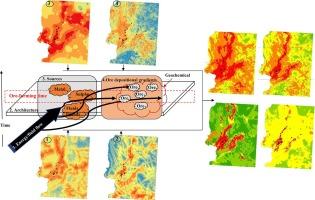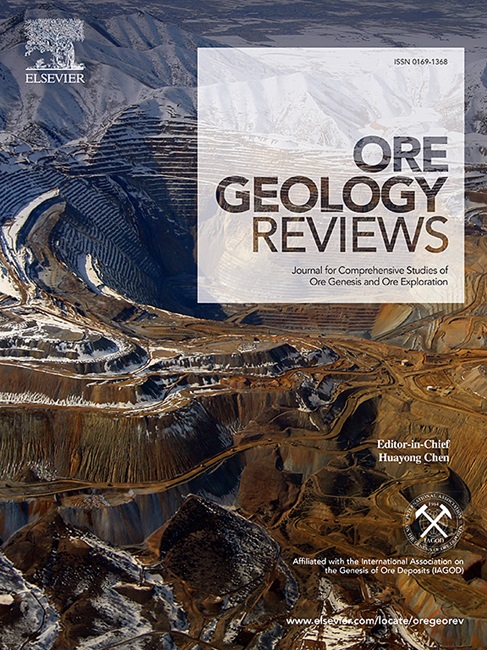将矿物系统标准转化为芬兰科拉里地区 IOCG 矿床的勘探模型
IF 3.2
2区 地球科学
Q1 GEOLOGY
引用次数: 0
摘要
矿产系统方法有助于利用矿产远景模型(MPM)绘制成矿地质过程的指纹图。它旨在减少勘探时间和成本,是矿产勘探行业的首要任务。芬兰冬季被厚厚的土壤、茂密的植被和积雪覆盖,因此露头地质有限,是这种方法的合适试验场。本文采用 MPM 预测了芬兰西北部科拉里地区铁-铜-金(IOCG)矿床的有利目标。矿物系统的组成部分矿石金属和硫源、路径、能源/驱动力、捕集器以及影响成矿过程的地质因素都被转化为可映射的标准,并被纳入区域尺度分析的考虑范围。知识驱动、模糊逻辑叠加、模糊推理系统和几何平均方法整合了来自地质(无比例尺地质图)、地球化学(耕层和基岩样本地球化学)和地球物理数据(磁力、辐射测量、电磁测量和重力蠕虫)的证据层。随后,采用概念/经验相结合的方法,即模糊证据层和逻辑回归,对数据进行建模。在探矿模型中,现有的 IOCG 矿床始终被置于高有利区域内。此外,还确定了新的勘探目标。利用接收者操作特征(ROC)分析和平均曲线下面积(AUC),根据已知的 IOCG 矿床对模型进行了验证,最终的远景模型值始终达到 0.8 分。这表明应用 MPM 取得了良好效果,使该方法适用于其他地区和矿床类型。我们采用了多数投票组合技术来合并每个远景模型的有利区域。然后采用置信度指数来减少与所生成模型相关的不确定性。这些结果始终有助于更可靠地确定勘探目标。本文章由计算机程序翻译,如有差异,请以英文原文为准。

Translating mineral systems criteria into a prospectivity model for IOCG deposits in the Kolari region, Finland
The mineral system approach facilitates mapping the fingerprints of geological processes in ore formation using mineral prospectivity modeling (MPM). It aims to reduce the time and cost of exploration as a priority in the mineral exploration industry. Finland, which is covered with thick soil, dense vegetation, and snow in winter and thus has limited outcrops, serves as a suitable testing ground for this method. In this contribution, MPM was employed to predict favorable targets for Fe-Cu-Au (IOCG) deposits in the Kolari region, northwestern Finland. The mineral system components ore metal and sulfur sources, pathways, energy sources/drivers, traps, and the geological factors influencing the ore-forming processes were translated into mappable criteria and were considered for a regional-scale analysis. Knowledge-driven, fuzzy logic overlay, fuzzy inference system, and geometric average methods integrate evidential layers derived from geological (scale-free geology map), geochemical (till and bedrock sample geochemistry), and geophysical data (magnetic, radiometric, electromagnetic measurements, and gravity worms). Subsequently, the data were modeled using a combined conceptual/empirical approach, i.e. fuzzified evidential layers and logistic regression. In the prospectivity models, existing IOCG deposits are consistently placed within high-favorability areas. In addition, new exploration targets were identified. The models were validated against known IOCG deposits using Receiver Operating Characteristic (ROC) analysis and average Area Under the Curve (AUC) with values of final prospectivity models consistently reaching scores > 0.8. This indicates a favorable outcome of the application of MPM, making the approach applicable to other regions and ore deposit types. A majority voting ensemble technique was employed to combine the favorable areas of each prospectivity model. Then a confidence index was adopted reducing uncertainty linked to the models generated. These outputs consistently facilitated the identification of exploration targets more reliably.
求助全文
通过发布文献求助,成功后即可免费获取论文全文。
去求助
来源期刊

Ore Geology Reviews
地学-地质学
CiteScore
6.50
自引率
27.30%
发文量
546
审稿时长
22.9 weeks
期刊介绍:
Ore Geology Reviews aims to familiarize all earth scientists with recent advances in a number of interconnected disciplines related to the study of, and search for, ore deposits. The reviews range from brief to longer contributions, but the journal preferentially publishes manuscripts that fill the niche between the commonly shorter journal articles and the comprehensive book coverages, and thus has a special appeal to many authors and readers.
 求助内容:
求助内容: 应助结果提醒方式:
应助结果提醒方式:


